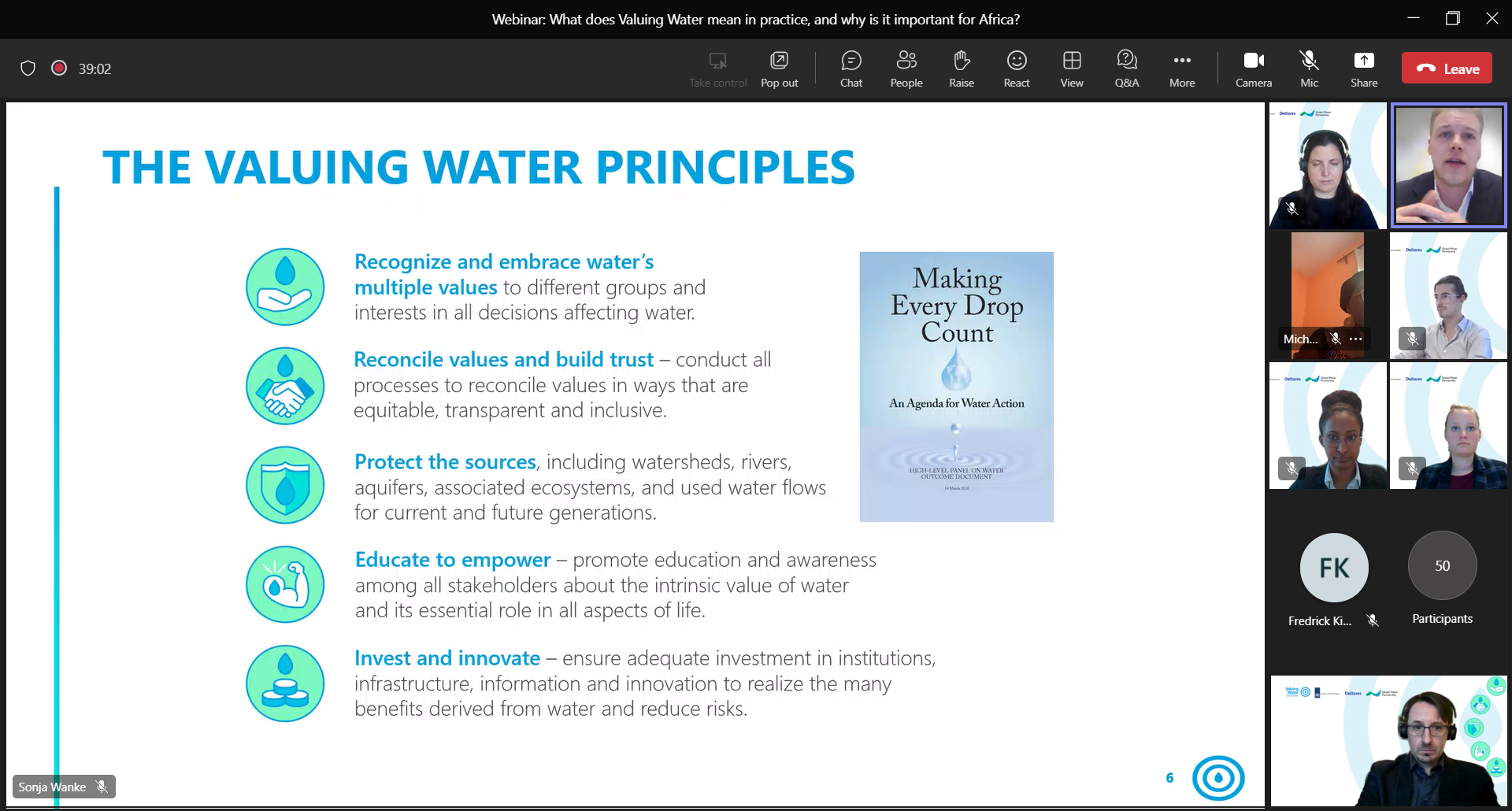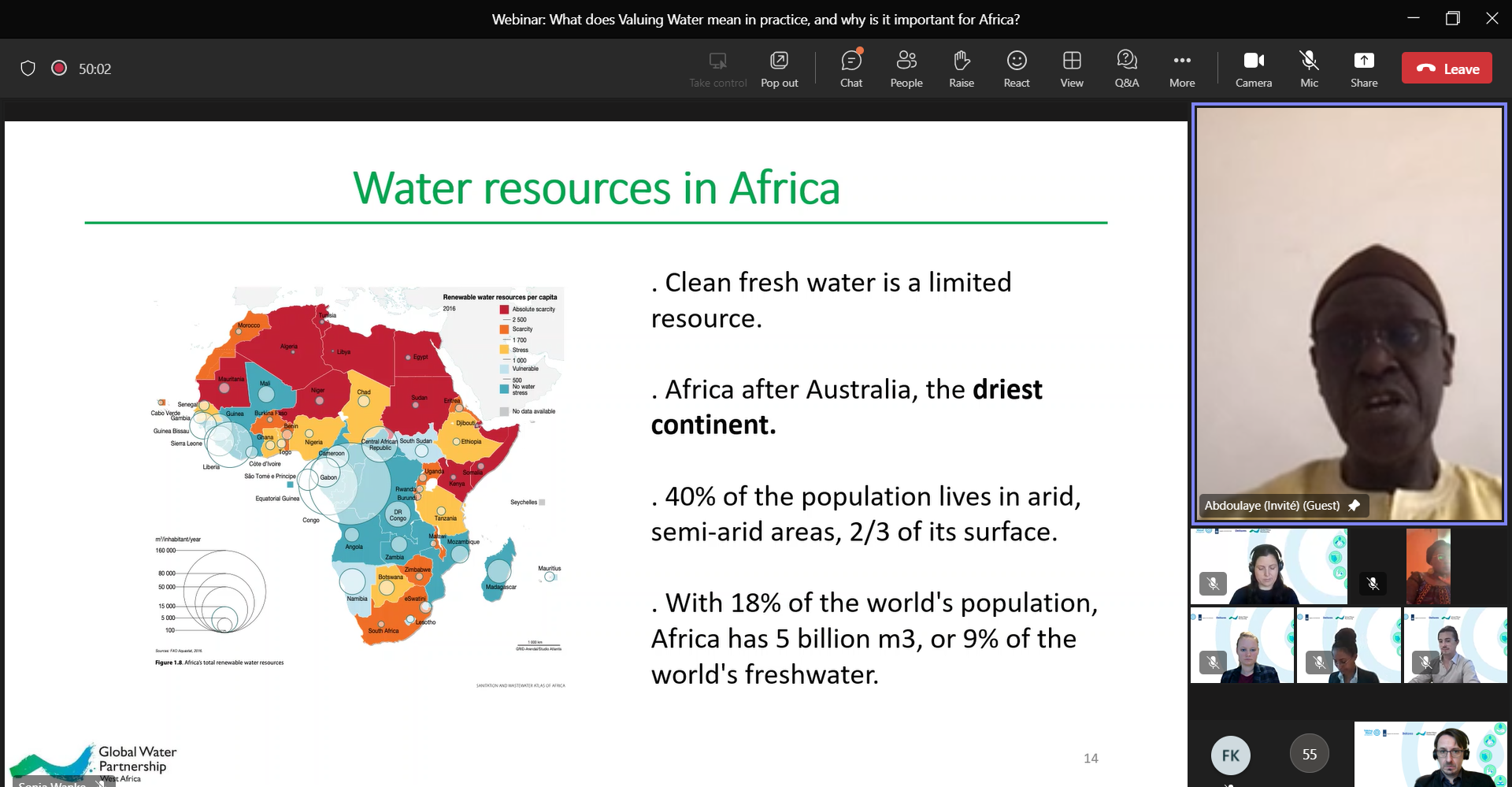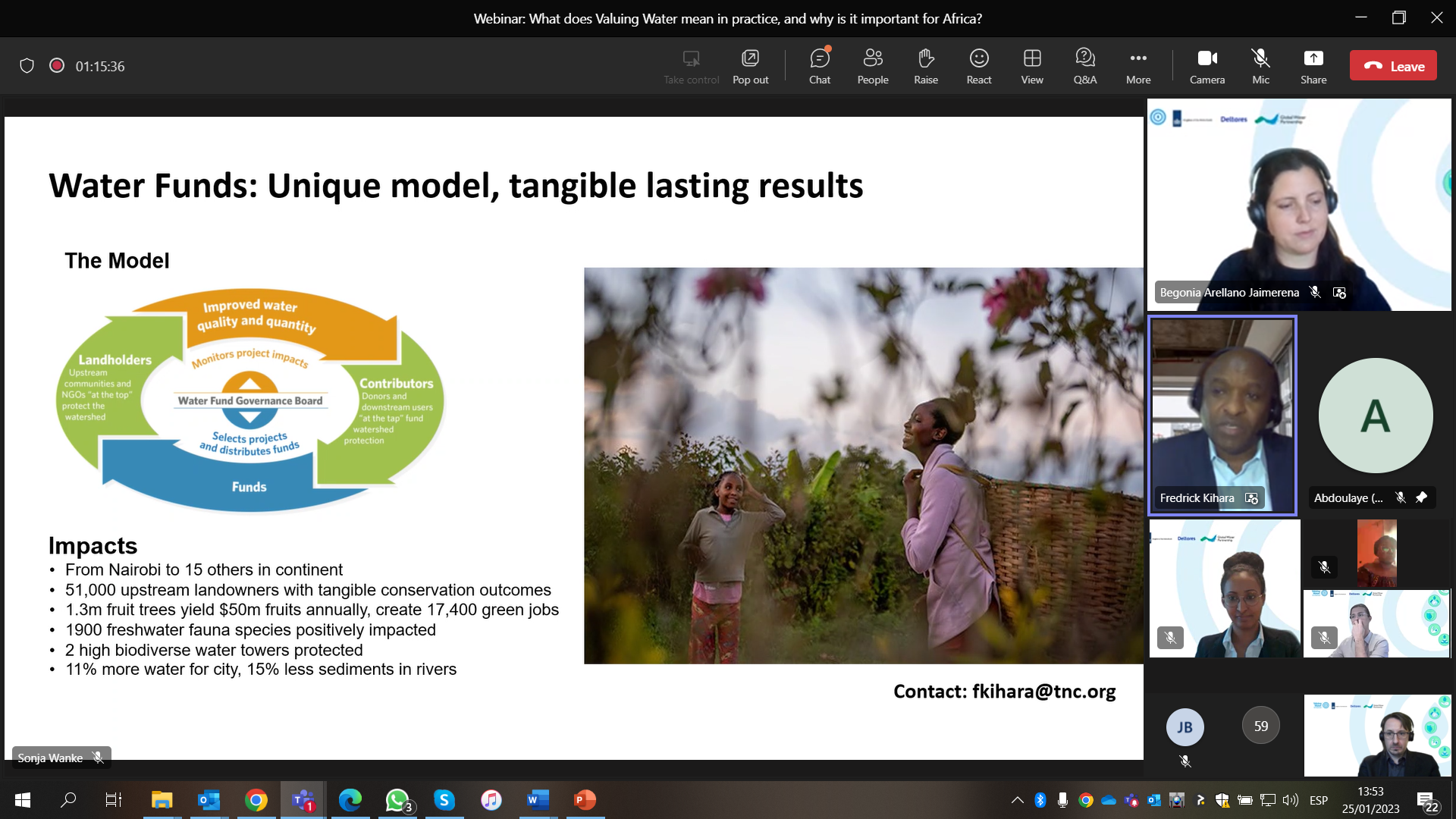What does Valuing Water mean in practice and why is it important for Africa?
Webinar:
25 January 2023
On January 25th, 2023, the Valuing Water Initiative (VWI), in collaboration with Deltares and the Global Water Partnership (GWP), organized a first webinar with a focus on Africa, as part of the regional process aiming to accelerate progress towards achievement of SDG6 through a greater valuing of water, in the run up to the UN 2023 Water Conference in March 2023. The webinar, which had almost 250 registered participants, served as a platform for four successful case studies in the region to be presented and discussed with the audience, who together reflected on how adopting a more explicit value lens in water management can improve water outcomes.
The event, moderated by Begoña Arellano from Deltares, began with a presentation by Joe Ray, VWI advisor, who explained that the Initiative emerged from the High-Level Panel on Water, which was convened by the UN and the World Bank in 2016 to support the implementation of SDG6 globally, and which brought together 11 different heads of state and government. The Panel formulated its recommendations in the report called Making Every Drop Count, which highlighted that we need to re-think how we value water, and to that end formulated five Valuing Water Principles (VWPs, see Figure 1). He explained that, since 2019, the implementation of these Principles has been supported by the VWI, hosted by the Government of the Netherlands.

Figure 1. The 5 UN Valuing Water Principles, as presented by Joe Ray
Subsequently, Mr. Ray explained the VWI theory of change, including a values lens and a system change perspective to contribute to the achievement of the SDGs through better decisions impacting water. He presented some journeys that the VWI has supported (Youth Journey, Financial Sector Journey, and Peru Journey) among other activities aiming to support implementation of the Principles. He explained that the VWI is just one attempt by the Dutch government to operationalise these principles, but there are many others, and he invited the audience to reflect on how they could translate this valuing water lens into tangible approaches, recognising and reconciling the multiple values of water. Finally, he stressed that this process can constitute an important regional input to the UN Water Conference in March 2023, and explained that the regional process will continue with a one-day working session in Cape Town on February 14th, in line with an IWMI event on Transformative Futures for Water Security initiative. The working session should allow the priorities for regional action to be understood, strengthening the position to be presented at the UN Water Conference.
To set the scene for why systemic thinking is needed in Africa, Abdoulaye Sene, Chair of GWP Western Africa and Secretary General of the 9th World Water Forum, then gave a keynote speech highlighting the main water challenges facing the continent (see Figure 2), including the following:
- Over 300 million Africans do not have access to clean drinking water.
- Over 700 million Africans live without access to adequate sanitation.
- With 18% of the world’s population, Africa has only 9% of the world’s freshwater.
- The population living under water stress in Africa is likely to increase from 47% in 2025 to 74% in 2040.
- The population of Africa is 1.4 billion, expected to grow to 2.5 billion by 2050, and 60% of the population will be living in urban settings by the 2050.
- 90% of Africa’s surface waters are found in 63 cross-border river basins, but only 29% of those river basins are the subject of an operational agreement between countries.
- Only 4% of Africa’s water is developed for irrigation, food and hydroelectricity.
- In 2015, Africa’s estimated investment needs per year to achieve SDG 6 by 2030 were $40 billion, whereas commitments to water were 13.2 billion dollars, or one third of the need.
- Achieving the SDG target on drinking water in Africa would require a 12-fold increase in current rates of progress, and for safely managed sanitation, the increase would need to be 20-fold.

Figure 2. Some of Africa’s water resources challenges, as presented by Abdoulaye Sene
Given these circumstances, Mr. Sene presented that, in 2021, the Assembly of AU Heads of State and Government adopted the Continental Africa Water Investment Programme (AIP) to close that investment gap. He also mentioned the outcomes of the 9th World Water Forum, held in Dakar, Senegal, and the Dakar “Blue Deal”, with its five pillars, which further aims to accelerate progress on water security and fill investment gaps.
Explaining that there are many good examples of solutions to Africa’s water-related challenges, Ms. Arellano then opened the webinar to presentations of and discussions around four case studies from different parts of the continent, in an interview format.
Strengthening Climate Resilience in the Kafue sub-Basin (SCRiKA) Project, Zambia
John Katonga Banda of the National Project Coordinating Unit, Zambia, gave some background on the Kafue sub-basin project, which received 8 million dollars in support through the Climate Investment Fund. He explained that the project has been running since 2014, until its current closing phase, and in that time has involved 1350 micro-community projects, reaching out to 272,000 beneficiaries, through local NGOs based in the communities. These communities have worked in a participatory approach to define which micro-projects they worked on, with a range of topics, from water efficient systems such as drip irrigation to solar-powered boreholes and efforts to avoid pollution of water sources. This approach to recognising multiple values while building trust between community members (VWP 2) was complemented through social marketing campaigns, with targeted messages to each community, including TV and radio programmes, road shows, a social media platform and even a popular drummer (VWP 4).
Upper Tana Water Fund, Kenya
Fred Kihara of The Nature Conservancy (TNC) presented on the Water Fund mechanism, initiated by TNC 23 years ago, and which brings both public and private sector together, with their respective values (VWP 1), to pool financial resources from downstream water users, to invest in the conservation and restoration of natural landscapes upstream, hand-in-hand with the local communities that live there. He noted that there are currently 44 Water Funds around the world, including fifteen under production in Africa, and an ever-growing demand. Mentioning the example of Africa’s first Water Fund, in the Upper Tana, in Kenya, Mr. Kihara showed how Water Funds are very much related to all five VWP. While their raison d’être is to protect source watersheds that provide important services to cities, as well as protecting biodiversity (VWP 3), additionally the Upper Tana Water Fund has been collaborating with and empowering 51,000 farmers (VWP 4), through innovative methods such as mobile phone platforms, which farmers have consented to receiving information through, in their local language (VWP 5). One of the tangible outcomes has been a 15% reduction in sediment in the rivers that are a major source of water supply.

Figure 3. Fred Kihara explaining the Water Funds model
The Water and Climate Network of Central African Youth Organisations (RECOJAC), Central Africa
Michèle Okala of RECOJAC then presented an approach implemented with local communities in the north of Cameroon, especially young people and women (VWP 4), through which water is made potable by using dry moringa seeds. The seeds are crushed into a powder which is then mixed with water drawn from traditional wells, even complemented with seawater, left for twenty-four hours, and then filtered to produce the potable drinking water. The quality of the water has been certified in laboratories as being appropriate for human consumption, which is especially important in this water-scarce region. The funding for this innovative project comes from multiple funding sources, starting with UNESCO, and local communities contribute in-kind with their hard work, meaning that the project is very unexpensive and locally owned (VWP 5). Beyond the immediate benefits of having access to good quality drinking water, this approach has also shown the importance of changing behaviour around water to take care of limited water resources.
Lake Chad Basin Commission
The final case was presented by Aminu L. Bala of the Lake Chad Basin Commission, located between West and Central Africa- Mr. Bala explained how the Lake Chad Vision 2025 has been established by riparian countries to encapsulate their shared values around protecting source watersheds and biodiversity (VWP 3), to ensure their shared water in the Lake. These values have been translated into a legally binding Water Charter, which generated trust between stakeholders (VWP 2). The Charter provides an equitable basis to govern the integrated and coordinated use of land and natural resources related to this shared water body. The translation of this approach into tangible actions has allowed for example data exchange to be formalised between countries, and the building of infrastructure of common interest, such as hydropower dams.
The interviews with the speakers allowed a positive light to be shed on how the adoption of the five VWPs can contribute to improving the water conditions of localities in Africa, both in physical and governance terms, and thus accelerate progress towards SDG 6, as well as other basic needs. In the same way, through the presentations, some additional success factors were highlighted, such as the need for a bottom-up approach, where the interests and values of local users are reconciled with decision makers through their active participation in governance platforms; and how a systemic change requires time, so it may be necessary to go beyond the lifetime of a single project approach.